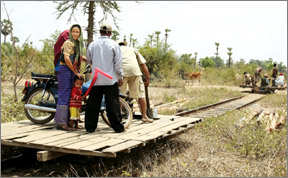Cambodia's "bamboo horse" keeps the people on track
Horn Tith's motto is: anytime, anywhere.
 Well, almost anywhere - as long as there are train tracks along which
he can drive his small, home-made "norry" train, one of many that ply
Cambodia's battered rail system. Well, almost anywhere - as long as there are train tracks along which
he can drive his small, home-made "norry" train, one of many that ply
Cambodia's battered rail system.
With the regular rail service in shambles, Cambodians for decades
have been driving these bamboo horses to carry goods and people the
length of the country.
"We can't wait for the trains, there is not enough service," said the
20-year-old amateur conductor as he hurried to put his norry together at
this isolated train station, a faded yellow blockhouse some 50
kilometres (31 miles) from the capital Phnom Penh.
Two axles stripped from derelict military vehicles were laid on the
tracks, and a bamboo platform set on top of them. A small gasoline
engine was wedged into a hole cut out of the platform and tied to one of
the axles with a rubber strap. The entire assembly took only a couple of
minutes and Horn Tith, who has been driving norries since he was 10
years old, called his half dozen passengers aboard.
"Even when people get sick, we can transport them anytime, even in
the middle of the night - quick, on-time service," he said. Cambodia's
rail system runs from the southwestern seaport of Sihanoukville to the
capital, finally terminating hundreds of kilometres (miles) away on the
northern border with Thailand.
But decades of war and neglect left vast stretches of track damaged,
making train travel a slow and uncomfortable experience. What few trains
remain only make the trips north or south from the capital once a week.
The roads in many parts of the country were no better, with rural
thoroughfares often little more than crumbling tracks or muddy paths
gouged through the rice fields. Looking for an easier, more reliable
form of mass transport, Cambodians began building norries in the 1980s.
Horn Tith admits that accidents were common in the chaos of those
early years, but this unofficial form of public transport has evolved
its own set of rules.
"There is only one track - so if two norries meet, the one with the
lighter load has to be taken off the rails so the other can pass," he
said.
"If they are carrying the same weight load, the one that is nearer to
the train station must return," he added. Long Sokhon arrived in Tbeng
Khpos hot and tired. The 50-year-old was travelling south with her
daughter and husband to see family and thought it only natural that she
take the norry.
"I wanted to have fun and see the view," she said.
More importantly, it kept her family off Cambodia's notoriously
dangerous highways, which are the scene of daily carnage as drivers in
vehicles big and small hurtle along the asphalt with little regard for
their own mortality.
"Taking the norry is much safer (because) you are driving on one-way
road," she said.
Also making the norry attractive for impoverished rural Cambodians is
the fact that a single fare can cost as little as a few US cents, Horn
Tith added.
"Villagers like to ride norries," he said. But the government has
been trying its best to stop the practice. The government two years ago
banned norries, saying that they were driving down train ridership,
officials said.
"We have never officially allowed norries to operate on the railroads
... it is illegal," said Uk Chan, a secretary of state at the transport
ministry who oversees Cambodia's railways.
Acknowledging that "our railroads have been poor since the war," Uk
Chan said 73 million dollars has been earmarked to restore the rail
system and to make rail travel faster.
"People will use the trains again," he said, adding however that the
rehabilitation, which starts in 2008, could take three years.
"Now we cannot ban norries from running because the villagers need
the transportation, so we just close our eyes and let them go," he said.
AFP
|
